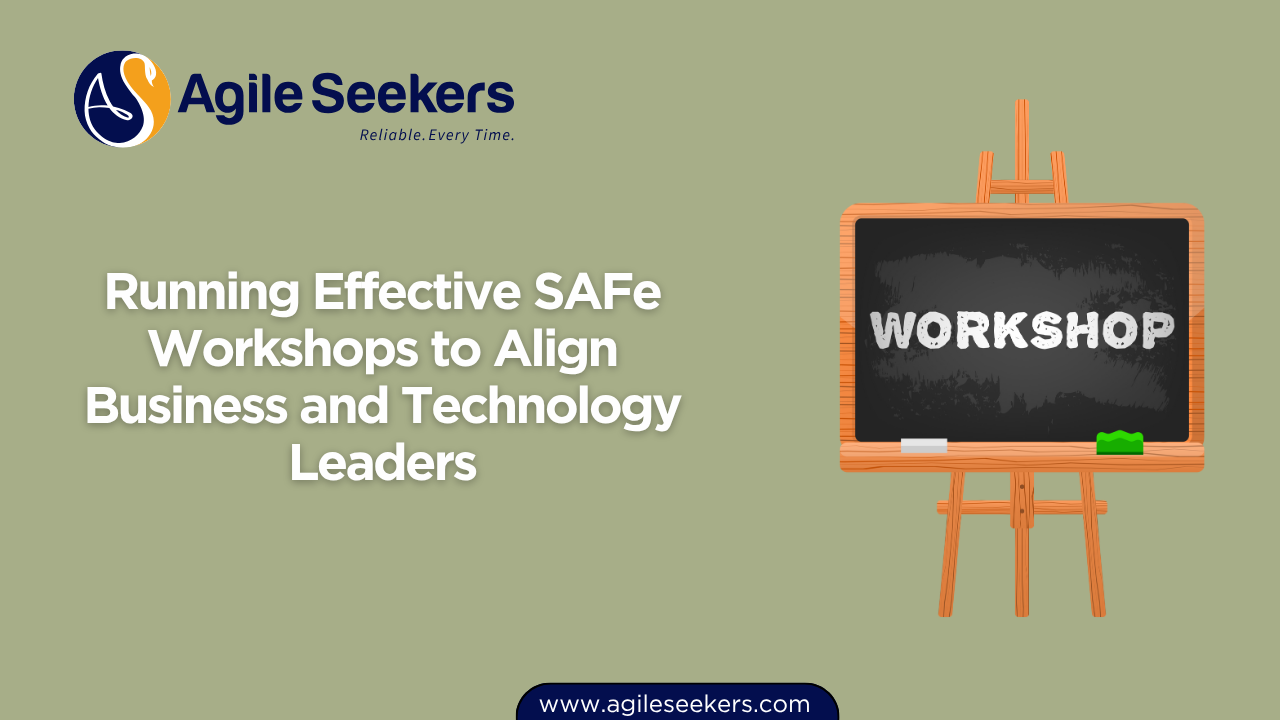Running Effective SAFe Workshops to Align Business and Technology Leaders

Successful implementation of the Scaled Agile Framework (SAFe®) hinges on one critical factor—alignment. Without clear alignment between business and technology leaders, even the most sophisticated Agile Release Train (ART) will lose momentum. Workshops provide a structured environment for facilitating this alignment, driving shared understanding, and building commitment across the enterprise.
This post explains how to plan and run high-impact SAFe workshops that bridge strategic thinking with delivery capability. It covers types of workshops, preparation techniques, facilitation strategies, and key takeaways to ensure every session moves your transformation forward.
Why SAFe Workshops Matter for Alignment
SAFe places a strong emphasis on synchronizing business objectives with Agile execution. Workshops create the forum for this synchronization. Whether you're defining a shared vision, prioritizing a portfolio backlog, or mapping a value stream, the goal remains the same—getting business and tech leaders on the same page.
A well-run SAFe workshop helps:
- Break down silos between functional teams
- Expose dependencies and constraints early
- Foster ownership and accountability
- Accelerate decision-making across organizational layers
Workshops are essential touchpoints in the SAFe implementation roadmap, especially for those attending the Leading SAFe Certification, where alignment is one of the key lean-agile leadership competencies.
Types of SAFe Workshops That Drive Alignment
Different phases of a SAFe transformation call for different workshop formats. Here are five that consistently deliver high value:
- Value Stream Identification Workshop
Helps leaders visualize how value flows across departments. Business and technical SMEs collaborate to identify operational and development value streams. This sets the foundation for launching Agile Release Trains (ARTs). - PI Planning Preparation Workshop
Typically held before the main Program Increment (PI) Planning event. Business stakeholders and Product Managers clarify strategic themes, architectural runway, and top features for prioritization. Those preparing for the SAFe POPM Certification will recognize the criticality of stakeholder alignment here. - Portfolio Visioning Workshop
Used to align business leaders, Epic Owners, and Enterprise Architects around portfolio themes and initiatives. These workshops support Lean Portfolio Management and are often facilitated by those in Release Train Engineer (RTE) or LPM roles. - Inspect & Adapt Workshop
Post-PI reflection workshops are vital to surface systemic issues and agree on improvement actions. This format enforces a continuous learning culture and aligns both strategy and execution. - OKRs and Outcome Alignment Workshop
Aligning strategic objectives (OKRs) to ART-level backlogs ensures everyone understands how delivery supports measurable business goals. This also builds the feedback loop into portfolio governance.
Prepping for a SAFe Workshop: What Matters Most
The groundwork you lay before the workshop determines its success. Leaders must invest time in preparation, not just show up expecting clarity to emerge on its own.
Here’s what to focus on before a SAFe workshop:
- Clear Workshop Objectives: Define what the session must accomplish—e.g., prioritize capabilities, identify dependencies, finalize ART backlog.
- Right Mix of Participants: Include business owners, Product Managers, Architects, Release Train Engineers, and Scrum Masters.
- Pre-reads and Pre-work: Share summaries, backlog items, roadmaps, or Lean Business Cases in advance.
- Tool Readiness: Ensure tools like Miro, Jira Align, or SAFe Collaborate are ready with templates and boards.
Those with a SAFe Scrum Master Certification often play a key role in setting this up and ensuring team readiness.
Facilitating the Workshop: Lead with Structure, Not Rigidity
Effective facilitation keeps the workshop on track while allowing space for creative discussion. A rigid agenda can choke collaboration. A loose one invites distraction. Striking the right balance is key.
Tips for effective facilitation:
- Time-box activities to maintain flow
- Use visual models like Kanban boards or roadmap heatmaps
- Document decisions in real-time to avoid churn
- Allow divergent then convergent thinking for better prioritization
Facilitators with SAFe Advanced Scrum Master Certification are particularly skilled at managing these dynamics.
Outcomes Over Outputs: Making Workshops Stick
A common failure pattern in many workshops is the lack of follow-through. Great conversations don’t move the needle unless they result in clear decisions and owned actions.
To drive outcomes:
- Define owners for each agreed action
- Follow up with visual summaries and tracking dashboards
- Integrate actions into the ART backlog or portfolio Kanban
Common Pitfalls to Avoid
| Pitfall | Impact |
|---|---|
| No clear facilitator | Chaos, off-topic discussions, time overrun |
| Lack of preparation | Unproductive debates, missed context |
| Business absence | No alignment on value, downstream rework |
| No documentation | Decisions lost, momentum stalls |
| Over-inviting people | Too many voices, slow progress |
Who Should Facilitate These Workshops?
Workshop facilitation in SAFe is not a one-person job. Depending on the session’s focus, different leaders can step in:
- RTEs often facilitate Inspect & Adapt and PI Planning workshops. Certification from SAFe Release Train Engineer Certification is highly recommended.
- Scrum Masters assist in team breakout sessions and execution readiness.
- Product Owners and Managers lead backlog alignment with insights from SAFe POPM Certification.
External Resources to Support Effective Workshops
If you're looking to boost your facilitation capability or explore templates, these links are useful:
Conclusion: Building Bridges with Intentional Conversations
SAFe workshops are not just events—they’re structured opportunities to align intent with action. When business and technology leaders meet in the same room with clarity of purpose and strong facilitation, transformation gains real momentum.
If you're leading a SAFe implementation, investing in workshop design and facilitation is not optional—it's essential. And if you want to deepen your expertise, consider certifications like Leading SAFe Certification, which emphasizes strategic alignment through lean-agile leadership.
Workshops that deliver alignment are workshops that deliver results.
Also read - Metrics That Matter: Monitoring Transformation Results in SAFe
Also see - Facilitating SAFe Strategy Workshops




















